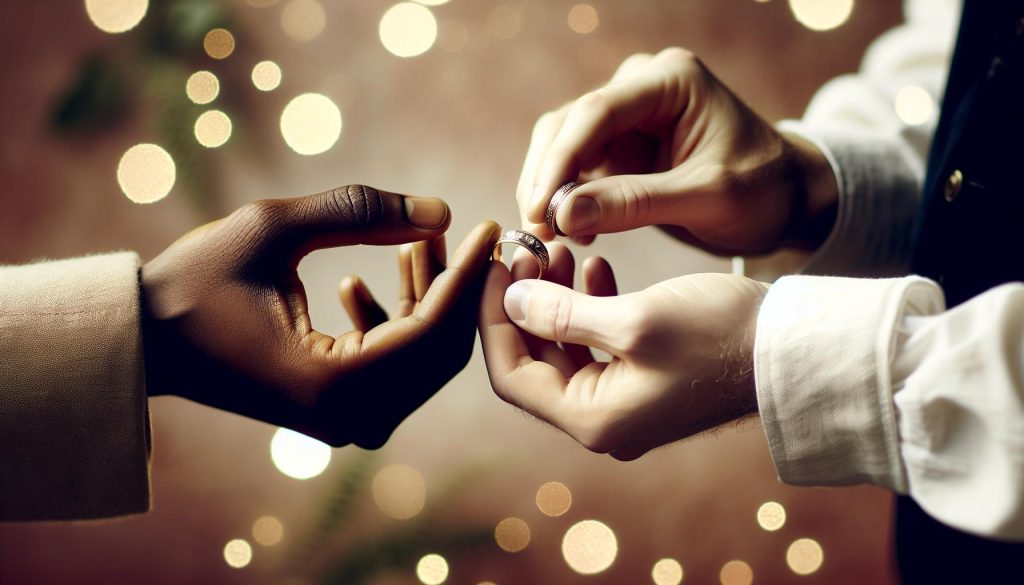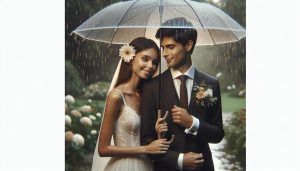When it comes to wedding bands, understanding proper ring placement is essential for honoring both tradition and personal preference. Did you know that many couples wear their wedding band closest to their heart, with the engagement ring above it? This simple choice not only reflects meaning but also sparks confusion. As you navigate through your wedding journey, knowing where to place your rings can enhance their significance and help you feel more connected to your commitment. Whether you’re blending customs or following a cherished family tradition, this guide will illuminate the different options and considerations around wedding band placement. Join us as we explore the beautiful nuances of ring placement, ensuring your choices resonate with your unique love story.
Where Should You Wear Your Wedding Band?
The placement of your wedding band is steeped in tradition and emotion, making it a significant part of your wedding attire. The most common practice is to wear the wedding band on the left hand’s ring finger, closest to the heart. This symbolizes the bond and commitment shared between partners. Typically, the wedding band is placed first, followed by the engagement ring, which rests above it. This order not only holds symbolic meaning but also ensures comfort and security on your finger, as noted in traditional practices [[1]](https://www.brilliantearth.com/wedding-rings/buying-guide/styling/) [[2]](https://www.theknot.com/content/what-goes-first-engagement-ring-or-wedding-ring).
When selecting the hand for your wedding band, consider both cultural norms and personal preferences. For example, in many Western cultures, the left hand is favored, while other cultures may opt for the right hand. It’s essential to choose a style and placement that resonates with your individuality and reflects your unique love story. Some couples may even choose to wear their wedding bands on different fingers or hands, blending tradition with modern interpretations [[3]](https://diamondrensu.com/blogs/engagement-rings/which-goes-first-engagement-or-wedding-ring?srsltid=AfmBOortTlhWjwubLJcqCgumvGCIydmVSg8NcSMyw_Y4suISCHyjpiUE).
As you embark on this exciting journey, remember there’s no rigid rule-your wedding band should feel right for you. Whether carefully following tradition or embracing a more contemporary statement, the choice is a celebration of your love. Each ring tells a story, and its placement is a reminder of the commitment you share.
Understanding Ring Etiquette and Tradition
Understanding how to appropriately wear your wedding band involves not only personal preference but also an appreciation of tradition and imbued meanings. The cultural significance surrounding wedding rings is rich and varied, shaping the way couples choose to display their commitment. The most recognized convention in Western cultures is to wear the wedding band on the left hand, specifically the ring finger, where it sits closest to the heart. This positioning symbolizes the deep emotional bond and love between partners, providing a tangible reminder of their commitment.
Traditionally, the wedding band is placed on the finger first, followed by the engagement ring. This order is more than just aesthetic; it reflects a journey-from the engagement to the marriage-and how these events interweave to form a unified commitment. For many, this sequence of rings is a comfort, as it is considerate of the rings’ fit and wear over time, preventing any potential damage to the engagement ring [[2]](https://www.brilliantearth.com/wedding-rings/buying-guide/styling/) [[3]](https://diamondrensu.com/blogs/wedding-bands/does-wedding-band-go-on-top-or-bottom?srsltid=AfmBOooKwjPXZizdPHclg19lGqui5qUMHEaeQo-bHRS69DPcPVFq30Ts).
However, it’s essential to remember that couples today are embracing flexibility in ring etiquette. As weddings evolve to reflect modern values, many couples opt for diverse styles or even placement on different hands. For some, wearing the wedding band on the right hand carries cultural significance, while others may choose a more personalized style that resonates with their unique love story. By exploring these variations, couples can find a method of wearing their wedding band that feels uniquely theirs, while still honoring the deeper meaning behind their choice.
The Perfect Placement: Ring Finger 101
Wearing your wedding band is a significant part of your personal expression of love and commitment, and understanding where to place it can enhance its meaning. Traditionally, the wedding band is worn on the left hand, specifically on the ring finger, as this position symbolizes closeness to the heart-a poignant reminder of your vows and the life you are building together. This longstanding tradition is rooted in a rich tapestry of cultural significance, with many viewing the left ring finger as the ideal location for showcasing one of life’s most treasured symbols.
When it comes to proper placement, the conventional order is to wear the wedding band first, closest to the heart, with the engagement ring stacked on top. This arrangement not only embraces tradition but also promotes comfort and seamless wear. Over time, having the wedding band at the base can protect the stones and setting of the engagement ring from daily wear and tear, as it often experiences more friction against surfaces and other rings. Additionally, this stacked method can create a more visually appealing look, setting off the sparkles of the engagement ring while maintaining an elegant presentation.
However, as modern love stories evolve, so too do their representations. Some couples choose to embrace their individuality by wearing their wedding bands on the right hand, making a bold statement that challenges traditional norms. Whether influenced by personal preference, cultural practices, or contemporary style, the significance behind your ring placement lies within the love it represents. Creating your own narrative around ring wearing not only honors your unique relationship but also allows you to celebrate the journey you’ve taken together. Ultimately, the decision of how and where to wear your wedding band should reflect your relationship-because it’s not just a piece of jewelry; it’s a powerful symbol of love.
Cultural Variations in Wedding Ring Placement
In various cultures, the placement of wedding bands reveals diverse traditions that shape the significance and visibility of these cherished symbols of love. While many Western countries traditionally place wedding bands on the left hand, specifically the ring finger, this is not universally adopted. For example, in countries like Germany and Norway, married couples often wear their wedding bands on the right hand, reflecting different cultural beliefs surrounding marriage and commitment.
Another fascinating variation can be found in Russian culture, where a triple rolling ring symbolizes marriage. This ring typically consists of three interlocking bands-one for each partner’s past, present, and future-signifying the unity of their lives together. The unique design and its meaning highlight how wedding rings can serve as storytelling pieces that express a couple’s journey.
In some Eastern cultures, the practice extends to more than just wearing, as rings may be exchanged publicly during ceremonies, demonstrating their significance to the wider community. This communal aspect emphasizes the role of the family and society in the couple’s union, making the ring a public declaration of commitment rather than a private token.
Given these cultural insights, it’s essential for couples to recognize that their choice in wedding band placement can be a beautiful blend of personal sentiment and cultural significance. Whether opting for traditional styles or incorporating elements from their unique backgrounds, couples are encouraged to make thoughtful decisions that honor both their relationship and cultural heritage, transforming their wedding bands into meaningful symbols that resonate deeply with their shared journey.
What to Know About Wearing Multiple Rings
Wearing multiple rings has become a popular trend, especially in the realm of weddings and engagements. For many couples, the challenge lies in determining not just the type of rings to wear, but also how to style them harmoniously on the same finger. When it comes to wearing both a wedding band and an engagement ring, the traditional approach is to wear the wedding band closest to the heart, with the engagement ring on top. This arrangement signifies the wedding’s foundational role in the relationship, augmented by the sparkle of the engagement ring shining above it.
One important consideration is the choice of metals and designs. Mixing different metals, such as gold and platinum or colored gemstones with diamonds, can create a stunning visual effect. However, it’s crucial to think about balance and coherence. For example, a delicate wedding band may not complement a larger, more elaborate engagement ring. To achieve a cohesive look, consider both the style and size of the rings. A wider band can create a visual anchor for the engagement ring, while more intricate designs might benefit from simpler wedding bands.
Another tip is to pay attention to the fit of each ring. Wedding bands and engagement rings should be properly sized so they comfortably fit together without causing discomfort. If you frequently wear multiple rings, consulting a professional jeweler about sizing adjustments can optimize your comfort. For those who like to follow trends, layering several rings can also add to your personal style statement. Mixing various textures, stones, and widths allows for endless creative combinations.
Overall, the placement and styling of multiple rings can be tailored to reflect your unique love story. Whether opting for a classic stacked arrangement or experimenting with bold choices, the key is to embrace what feels right for you. Celebrate your journey by showcasing your rings in a way that holds meaning and highlights your individual style, all while being mindful of comfort and aesthetic harmony.
Engagement Ring vs. Wedding Band: Placement Tips
When it comes to wearing your wedding band and engagement ring, the placement can hold significant meaning and offer a touch of personal style. Traditionally, the wedding band is worn first, closest to the heart, to symbolize the solid foundation of your marriage, while the engagement ring sits on top, representing the love that led to your union. This arrangement not only emphasizes the commitment but also creates a stacked look that can be beautifully personalized.
To create a harmonious and visually appealing stack, consider the styles and materials of both rings. Here are a few tips to keep in mind:
- Metal Harmony: If your wedding band is gold, consider an engagement ring that incorporates similar gold tones or complementary metals. This unity helps in achieving a cohesive look.
- Design Complementation: Pair intricate designs with simpler styles. For example, if your engagement ring features a complex halo setting, a classic, plain wedding band can enhance its beauty without overwhelming it.
- Width Considerations: The width of each band matters. A wider wedding band can provide balance for a larger engagement ring, preventing the stack from feeling top-heavy.
- Comfort Factor: Ensure both rings fit well together. A snug fitting is essential, especially if you’ll be wearing them daily. Consider visiting a jeweler for adjustments if needed.
After your wedding day, it’s common for brides to wear just their wedding band if they prefer a more understated look. Alternatively, many choose to wear both rings to showcase their full commitment. For those who love to accessorize, layering additional rings alongside your bands can also be a trendy option, allowing for creative expression. The key is to celebrate your unique story and style through the placement of your rings, making sure they tell the narrative of your love in a way that feels authentic to you.
How to Choose the Right Hand for Your Bands
When it comes to selecting which hand to wear your wedding band and engagement ring, there’s a delightful blend of tradition and personal expression at play. The most common practice in many Western cultures is to wear both rings on the left hand, with the wedding band positioned closest to the heart and the engagement ring stacked on top. This arrangement symbolizes the deep connection and commitment that marriage represents. However, some individuals choose to wear their wedding band on the right hand, either for personal preference or as a meaningful choice reflecting their identity.
Many cultures have their unique customs regarding ring placement. For example, in some Eastern European countries, it is traditional to wear wedding rings on the right hand. This choice may stem from historical beliefs or symbolize a different spiritual connection. Couples should feel encouraged to consider these cultural perspectives when deciding how to wear their rings, allowing them to honor their backgrounds and beliefs while crafting their own narrative.
To help in this decision, consider the following factors:
- Comfort: Choose a hand that feels natural for you, ensuring that you can wear your rings without discomfort during daily activities.
- Personal Style: Reflect on your personal aesthetic. If you tend to favor left-handed styling, wearing your rings on the left may enhance your overall look.
- Symbolism: Think about what feels significant. Some may feel a stronger connection with their rings on the left hand, while others might prefer the right for various reasons.
- Practical Considerations: If you engage in physical activities or work that may not be ring-friendly, you might choose to wear your wedding band on a less dominant hand to minimize the risk of damage or discomfort.
Ultimately, the decision on which hand to wear your wedding band and engagement ring should resonate with your values, preferences, and lifestyle. It’s a chance to tell your love story in a way that feels completely yours, allowing the symbolism of the rings to shine brightly within your chosen context. Embrace this moment in your wedding planning journey as an expression of your love and commitment, celebrating the beautiful connections that define your relationship.
Creative Ways to Showcase Your Wedding Band
Creative ring displays can enhance both the aesthetic appeal and the emotional significance of your wedding band during your special day and beyond. While wearing your ring is the most traditional way to showcase it, there are numerous inventive ways to highlight this cherished symbol of love, allowing it to shine brightly in your wedding narrative.
A popular method is to include your wedding band in your wedding photography. Consider incorporating your ring into detail shots of other wedding elements, like the bouquet, invitations, or decorative pieces. This not only personalizes your photography but also captures the ring’s connection to your wedding story. You might also think about displaying your rings on a beautiful ring pillow during the ceremony or by having them delicately presented in a custom box that reflects your wedding style.
Engaging Display Ideas
- Shadow Box Frames: Create a beautiful shadow box to house your wedding band alongside other meaningful items from your wedding day, such as a piece of fabric from your dress or wedding vows.
- Personalized Display Stands: Utilize elegant display stands or easels at your reception to showcase your wedding rings, allowing guests to admire them while sharing in your love story.
- Custom Jewelry Dish: Have a jewelry dish made from materials that match your wedding colors or theme, ensuring that your ring has a beautiful resting place when not being worn.
Another creative approach is to use your rings as part of the wedding décor. For instance, you can have mini replicas of your rings scattered across tables or incorporated into centerpieces, signaling their importance and sparking conversation among guests.
Ultimately, how you showcase your wedding band should reflect your personal style and the significance of the ring within your love story. Whether through imaginative photography, unique displays, or intentional décor, these creative methods empower you to celebrate your union in delightful and memorable ways. Embrace this opportunity to express your love and commitment beyond traditional placements, making your wedding day truly unforgettable.
Common Mistakes to Avoid with Ring Placement
Wearing your wedding band is a moment steeped in importance, yet there are common missteps that can diminish its significance. One frequent mistake is disregarding the traditional stacking order of rings. The custom dictates that the wedding band is worn closest to the heart, followed by the engagement ring. Not only does this preserve the symbolic intention behind the rings, but it also offers a visually cohesive look that enhances the beauty of your set.
Another error is neglecting to consider the fit and comfort of your rings. Wearing a wedding band that is too tight can cause discomfort, especially during the festivities. Ensure that your rings are appropriately sized and comfortable to wear throughout the day. It’s advisable to try them on at different times leading up to the wedding day, as finger sizes can fluctuate due to factors like temperature and hydration.
Be mindful of how your rings may interact with each other. Some couples overlook the potential for scratching or damage when rings are stacked, particularly with more fragile stones or delicate bands. Opt for a wedding band that complements the engagement ring while being more durable, ensuring longevity for both pieces. Additionally, regularly assess how your rings sit together to prevent any accidental snagging or shifting that could impair their condition.
Lastly, be aware of the cultural significance surrounding ring placement. Different cultures have unique customs regarding which hand to wear the wedding band on, and failing to consider this aspect can lead to inadvertent disrespect. Embrace the traditions that resonate with you, whether leaning into longstanding practices or paving a new path that reflects your personal story. Celebrating the journey of your love means honoring the symbols that mark your commitment while ensuring they are worn thoughtfully and with care.
The Impact of Wedding Band Placement on Style
Choosing the right placement for your wedding band is not just about adhering to tradition; it can significantly affect your overall style and aesthetic. The placement of your wedding band-whether worn alone or stacked with an engagement ring-can highlight your personal fashion choices, compliment your wedding attire, and even reflect your personality. For many, the wedding band worn closest to the heart signifies not only love but also enhances the visual engagement of both rings, creating a harmonious and cohesive look.
When considering how to style your rings, think about the metal tones and gemstones involved. Mixing metals can be a bold fashion statement, but if you prefer a more classic look, wearing bands that share similar tones can create a seamless effect. For example, if your engagement ring is set in white gold, a matching wedding band in the same material can enhance its brilliance and maintain a unified presentation. This choice is essential to consider, especially during the planning of your wedding day ensemble, as every detail counts in creating that perfect look.
The design of your wedding band also plays a pivotal role in its impact on style. Styles range from ornate, intricate bands that add flair to minimalist designs that allow the engagement ring to take center stage. If you’re inclined toward a more ornate engagement ring, pairing it with a simple wedding band can create balance, ensuring neither piece overshadows the other. Conversely, if both rings are on the delicate side, layering them can add elegance and sophistication that appeals to modern sensibilities.
Lastly, consider your lifestyle when deciding on the placement and style. Active individuals may benefit from a smooth, rounded band that minimizes catch points, while others might enjoy more elaborate designs. Understanding how your ring placement interacts with everyday activities can ensure that you feel comfortable while also looking your best.
In summary, the thoughtful selection and placement of your wedding band can significantly enhance your overall style, making it not just a piece of jewelry but a cherished symbol of love and partnership beautifully expressed through personal flair. By carefully considering materials, design, and lifestyle, you can confidently showcase your wedding rings while honoring the significance they hold.
Rings and Symbolism: Meaning Behind Your Choice
Choosing a wedding band is not merely about selecting a beautiful piece of jewelry; it’s a personal journey that reflects the values and emotions of your relationship. The symbolism behind your choice in rings can convey deep meaning that extends beyond aesthetics. Many people opt to wear their wedding band closest to their heart, representing an eternal connection and unwavering commitment to their partner. This placement signifies that love is foundational – the wedding band often symbolizes the promises made during the wedding vows, while the engagement ring represents the intention behind those promises.
When considering the design and material of your wedding band, think about what resonates with you and your partner. Some may choose classic gold or platinum for its timeless appeal, while others might lean towards unique materials such as titanium or ceramic. The symbolism can also be enhanced through personal engravings, gemstones, or designs that hold specific meanings to the couple. For example, a band adorned with birthstones or meaningful inscriptions is a tangible reminder of shared memories and aspirations.
Cultural context also plays a significant role in understanding the symbolism of wedding bands. In various cultures, the hand on which a ring is worn can carry distinct meanings. For instance, in many Western traditions, wedding bands are worn on the left hand’s ring finger, believed to have a “vein of love” leading directly to the heart. Conversely, in some Eastern European cultures, the wedding ring is worn on the right hand, symbolizing both unity and fidelity. By understanding these cultural nuances, couples can choose a ring placement that aligns with their heritage or personal beliefs.
Ultimately, your wedding band should reflect your relationship’s unique journey and the promises you make to each other. Embrace the joy that comes with the planning process, knowing that every choice you make contributes to a story filled with meaning and love. Whether opting for traditional choices or forging a new path, let your rings be symbols of the bond you cherish. Each time you glance at your band, may it serve as a beautiful reminder of the commitment and love you share.
Maintaining Your Rings: Care and Considerations
When it comes to cherishing the meaningful symbols of your love, proper care and maintenance of your wedding and engagement rings is essential. These treasured pieces not only encapsulate significant moments but also require attention to ensure they remain as radiant as the day you exchanged them. With a few practical tips, you can keep your rings in stunning condition while celebrating the commitment they represent.
To maintain the brilliance of your rings, regular cleaning is key. Consider using a gentle solution of warm water and a few drops of mild dish soap. Soak your rings for about 20 to 30 minutes, then brush them lightly with a soft toothbrush to remove any buildup. Rinse them thoroughly and dry with a soft, lint-free cloth. This simple routine can help prevent dullness caused by everyday wear. However, remember to remove your rings during activities that could cause scratches or damage, such as exercising or house cleaning.
Storing Your Rings Safely
Proper storage is just as important as cleaning. Invest in a dedicated jewelry box or a soft pouch specifically for your rings. This will protect them from potential scratches and entanglement with other pieces. If your rings feature softer gemstones or intricate designs, consider placing them in a padded compartment to avoid unnecessary wear.
Regular Professional Check-ups
Just like any cherished possession, periodic professional assessments can extend the life of your rings. Schedule annual inspections with a trusted jeweler to check for loose stones, wear and tear, and any necessary repairs. This proactive approach can save you from potential heartbreak down the line and keep your rings secure and looking their best for years to come.
Ultimately, your wedding and engagement rings should sparkle not only as symbols of your love but also from the care you provide them. By incorporating these caring practices into your routine, you honor the commitment encapsulated in your rings, ensuring they continue to shine brightly through the various phases of your shared journey.
Frequently Asked Questions
Q: Where does the wedding band go on your finger?
A: Traditionally, the wedding band is worn closest to the heart, positioned on the ring finger of your left hand, followed by the engagement ring. This placement symbolizes the bond of marriage, but personal preferences and cultural variations may lead to different arrangements.
Q: Can you wear your wedding band and engagement ring on different hands?
A: Yes, wearing your wedding band and engagement ring on different hands is perfectly acceptable. Some prefer to wear both on the dominant hand for ease, while others may choose the left hand for tradition. Ultimately, it’s about what feels good for you.
Q: Do you wear the wedding band on top or bottom?
A: The wedding band is typically worn on the bottom, closer to the palm, with the engagement ring above it. This arrangement emphasizes the engagement ring’s design while keeping the wedding band positioned in line with the marital commitment.
Q: Can I wear my wedding band as a fashion ring?
A: Absolutely! Many choose to wear their wedding band as a fashion ring. If you want to showcase it frequently, consider styling it alongside other rings. Make sure it matches your style and reflects your personal aesthetic.
Q: Is there an etiquette for wearing multiple rings?
A: While there are no strict rules, consider wearing your wedding band at the base of your ring finger to maintain lineage with tradition. Mix styles and metals thoughtfully to create a balanced look, and remember to keep comfort in mind.
Q: What should I do if my wedding band feels too tight or loose?
A: If your wedding band feels uncomfortable, consult a professional jeweler for resizing. It’s essential to ensure a proper fit for both comfort and security. Consider seasonal changes in your finger size when selecting your ideal fit.
Q: Why do some cultures wear wedding bands on the right hand?
A: In some cultures, such as in certain European countries and Jewish traditions, wedding bands are worn on the right hand. This variation often signifies different customs or religious beliefs surrounding marriage and commitment.
Q: How can I creatively showcase my wedding band?
A: To creatively showcase your wedding band, layer it with other rings or wear it on a chain as a pendant. You can also consider custom styling options to enhance its visual appeal while reflecting your personal style.
For more information on ring etiquette and cultural variations, check out the sections in our article on engagement ring and wedding band placement.
Future Outlook
As you prepare for your special day, remember that understanding proper wedding band placement not only enhances your ring’s beauty but also reflects the meaningful commitment it represents. If you still have questions about the best ways to showcase your rings or want to explore different styles, be sure to check out our articles on choosing the perfect engagement ring and wedding venue selection; they provide valuable insights to enhance your wedding planning experience.
Don’t forget to subscribe to our newsletter for expert tips and the latest trends in wedding planning delivered straight to your inbox! Embrace this beautiful journey with confidence, and share your thoughts or experiences in the comments below-your insights could inspire fellow couples. Let’s celebrate love together, and keep discovering the joy of wedding planning!










